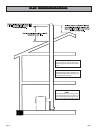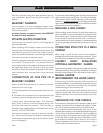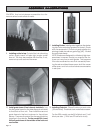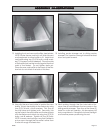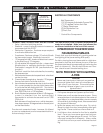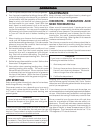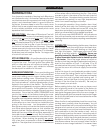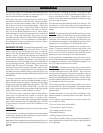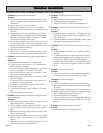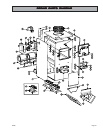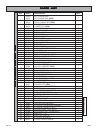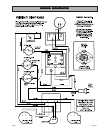
Page 16 USSC
5.
6.
7.
8.
9.
10.
Push in bypass damper after fire has progressed.
Your furnace is capable of putting out many BTU's,
so don't fully load your furnace until you have be-
come familiar with the operation of the furnace.
Keep in mind, a full load will not always give you
the best results for your needs. Note: With new
steel, there is a small amount of oil or dirt on the
metal. You may smell an odor. This is normal dur-
ing the first operation. You may want to assemble
the furnace out of doors and build a small fire in it
to "burn off" this dirt and oil before installing the
unit.
When loading your furnace that has existing hot
coals, pull the bypass damper out and rake the
red hot embers over grate evenly. Put a few smaller
pieces of wood on the coals first, then load up to
the middle of the feed door.
Set rheostat setting for type and condition of coal
or wood. Hard coal and wood requires more
forced air than soft, so experiment with dial set-
ting. Start with a center dial setting. The draft fan
cover also requires experimenting with. Start with
a 20% opening.
Set the furnace thermostat for comfort. Set the other
thermostat 10 degrees lower.
Use caution when opening loading door. Avoid
opening loading door rapidly. This could cause
flames to flash out the door. This occurs when there
is unburned fuel and a large amount of gases on
the top of the firebox. When the door is opened
oxygen is combined with the gases and ignites.
ASH REMOVAL
Every morning when there is just a bed of hot embers,
shake the grate very, very lightly.
Once every week or two, depending on how much
fuel you burn, ashes should be removed. Note: A 2"
to 3" bed of ashes will prolong wood burning and
protect grates.
To remove ash pan simply open ash door and pull out
your ash pan. But remember, the ash pan can get
very hot. Dump ashes in a metal container with a lid
and place on a non-combustible surface.
CAUTION
Never let ashes build up to grate level. This will
reduce the life span of your grate, and void grate
warranty.
CAUTION
Never use anything but a metal container to put
your ashes in. Every year fires are caused by empty-
ing ashes into cardboard boxes or paper bags.
MAINTENANCE
Keep chimney and flue pipe clean by cleaning at
least twice during a heating season.
CREOSOTE- FORMATION AND
NEED FOR REMOVAL
When wood is burned slowly, it produces tar and
other organic vapors which combine with expelled
moisture to form creosote. The creosote vapors con-
dense in the relatively cool chimney flue of a slow
burning fire. As a result, creosote residue accumu-
lates on the flue lining. When ignited, this creosote
makes an extremely hot fire.
The chimney connector and chimney should be in-
spected at least twice monthly during the heating
season to determine if a creosote buildup has oc-
curred.
If creosote has accumulated, it should be removed
to reduce the risk of a chimney fire.
Keeping your chimney and stove pipe clean is the
best insurance against chimney fires. Note: Smoke
detectors and fire extinguishers should always be a
part of your equipment.
If you clean your own chimney and stove pipe, we
recommended purchasing the equipment profession-
als use. Wire brushes are available in enough sizes
and shapes to be a snug fit inside any common flue.
Once a week let your furnace burn with ash door
open for a maximum of fifteen minutes while in at-
tendance. This will help minimize creosote buildup.
Also placing a surface magnetic thermometer on
flue pipe is helpful to keep temperatures at 300 to
400 degrees. Duct temperatures should be 115 to
125 degrees at 12" above furnace.
CAUTION
If you have a chimney fire, we recommend the
following immediate actions:
1.
2.
3.
Alert everyone in the house.
Shut any furnace doors, disconnect power to
the unit, and close any dampers. This should
take no longer than a few seconds.
Call the fire department.
OPERAOPERA
OPERAOPERA
OPERA
TIONTION
TIONTION
TION



